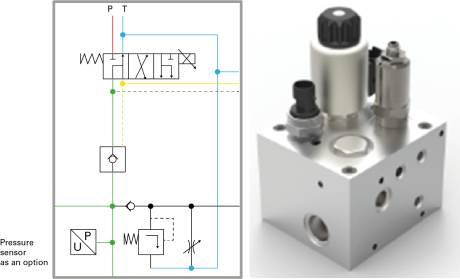Wolfgang Bauer and Marcus Fischer –
Modular, economic and of easy application. Argo-Hytos presents a new modular new hydro-pneumatic suspension system.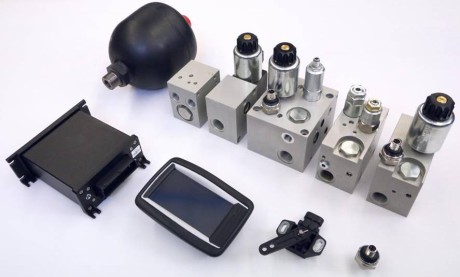
Hydro-pneumatic suspension systems improve comfort and productivity of vehicles. The fact that these systems are currently utilized in only a small number of vehicles is mainly due to high development efforts and the additional costs of the suspension components. Argo-Hytos now offers a modular system, which features an improved cost-benefit ratio and a reduced development effort. Moreover, two specially developed hydraulic solutions offer distinct advantages over currently used systems.
Comfort, productivity, and profitability are among the most important qualities customers request from work machines today. Higher standards demanded with regard to comfort are impelled particularly by the Health and Safety directive 2002/44/EG, which defines the daily permissible vibration exposure to the driver. In other words, the less vibration the driver feels, the more comfortably the driver rides and therefore, the longer the driver is allowed to work. Especially during off-road work, this criterion may determine whether a driver is allowed to perform a certain job for the entire workday or whether the drivers must stop their work before the workday is done. Hence, comfort is not merely a condition of personal well-being; it is an important factor when it comes to the actual permissible daily working hours. Therefore, it also influences profitability. Additionally, an increase in comfort will allow the driver to complete work processes faster and with more precision, which in turn makes the driver’s work more productive. This helps to enhance profitability, as well.
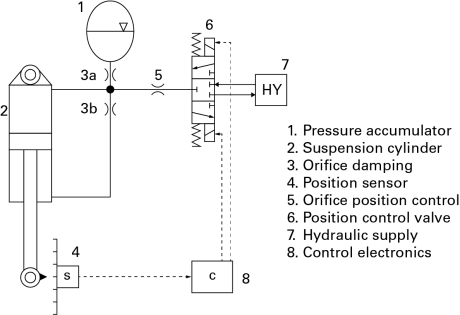
In order to achieve this kind of comfort it is necessary to have a suspension system that isolates the vehicle’s chassis, or rather, the driver from the unevenness of the ground. Hydro-pneumatic suspension systems can be located in various parts of a vehicle. Typically, there are three different applications – wheel or axle suspension, operator’s cab suspension, and boom suspension or suspension of payload. There is another important advantage with regard to wheel and/or axle suspensions – wheel load or ground pressure is equalized, which in turn enhances road-holding and wheel traction. This leads to increased efficiency and productivity, which consequently improves profitability.Typically, vehicles subjected to frequent load changes have level-controlled suspensions. In many cases, this is a hydro-pneumatic suspension, i.e. a system consisting of suspension cylinders and accumulators as well as a position control system (see fig. 1).
At present, usually only premium-class vehicles and vehicles that are produced in large quantities are equipped with such suspension systems. Various special applications, for which a suspension is indispensable, also use them. There are two main reasons for this – high development costs (hence, product costs), and long development times. These two reasons apply especially when an OEM introduces a suspension system into their vehicle for the first time or when the next evolutionary stage of suspension is to be launched. Often, these are exactly the obstacles that make OEMs decide against a suspension system, despite the clear advantages described above.
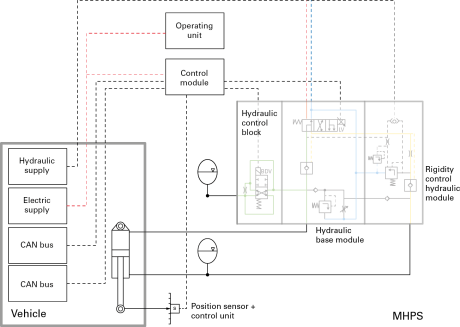
The target of Argo-Hytos is therefore to remove these barriers for OEMs and to advance the technology of hydro-pneumatic suspension systems. Development costs and development time shall be reduced considerably. This is accomplished with a new system solution, which is characterized by three particular benefits:
A standardized, modular control system for hydro-pneumatic suspension systems – including hydraulics and electron ics
A straightforward adaptation of the system to customer-specific needs simply by choosing appropriate modules and parameter settings
Technical advice and support concerning the layout of the overall suspension system and its interaction with the vehicle.
Applicative advantages
The advantages for OEMs are:
1.Prototype systems are available very quickly
- Standard modules that have been adapted for a specific application can be utilized as a series production solution for small to medium quantities
- For large quantities and/or specific requirements concerning installation space, a customer- specific hydraulic manifold can be derived from the prototype.
The modular control system developed on this basis consists of a hydraulic manifold, which is connected to an electronic control unit, as shown in fig.2. The electronic unit is the command and control center; it coordinates and regulates all of the functions of the hydraulic manifold. The necessary input for these decisions is provided by data from the operating panel, various sensors and the vehicle’s bus system. The hydraulic manifold is connected to the suspension cylinder so it can control the position of the cylinder and the pressure within the cylinder’s rod-side chamber. Additionally, the hydraulic manifold can be connected to the piston chamber’s pressure reservoir, which allows for damping control or the hydraulic blocking of the suspension.
Moreover, there is a connection between the control system and the vehicle for hydraulic and electric energy supply. Load-sensing systems (standard and ‘common rail’) with fixed and variable displacement pumps are supported; supply voltage of 12 to 24 V is possible.
The adaptation of the system to customer-specific requirements is achieved by selecting appropriate modules and their settings. With regard to hydraulics, there are various modules which can operate all types of hydro-pneumatic suspension systems (single-acting, double-acting, constant or variably preloaded, etc.).
The basic module consists of a minimum of required hydraulic components. It is a manifold that provides position control of the suspension: it feeds or drains oil to/from the suspension cylinder’s piston chamber. A special feature of it: it needs just one proportional valve with only one solenoid (see fig.3), for upward and downward leveling. There are two advantages here as opposed to suspension manifolds commonly used at present; one solenoid can be eliminated, additionally the position adjustment can be done proportionally. This means that the valve can on react very sensitively to small changes in position and open fully (control range 2.5 to 25 lpm at 20 bar Dp). Therefore the required position can be reached faster, for example while under extreme load changes or in cold temperature conditions with high oil viscosity. Patent applications have been filed for the valve and its integration in the circuit of the position control manifold.
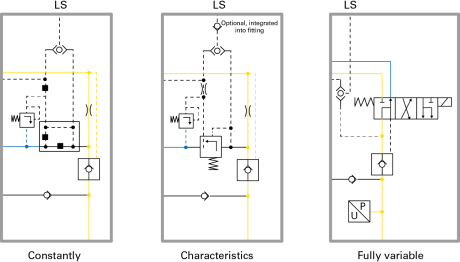
Additionally, there are rod-side control modules for the setting of the rod-side pressure in preloaded suspension systems (fig.4). Using these, the spring rate of the system can be varied in a wide range.
Three regulation typologies
Three regulation typologies are available, permitting a broad variation of the spring reaction (that is to say of the suspension response rigidity).
Here are the three typologies, as follows:
1. Hydro-mechanic control system with constant pressure.
2. Hydro-mechanic control system with variable pressure that follows the characteristic curve set according to the load that rests on the suspension. It is highly suggested for tractors and it was patented in Germany. Compared to systems with two-level road-side pressure variation, our system allows a continuous and smooth pressure variation in the rod-side chamber and therefore a suitable spring response variation for any case of sudden variation of the load on the suspension.
3. Fully variable control system that, using a 4ways/3 positions proportional directional valve, combined with a pressure sensor, permits a constant control of the pressure on the rod-side chamber and therefore an optimization of the suspension spring reaction at the load variation.
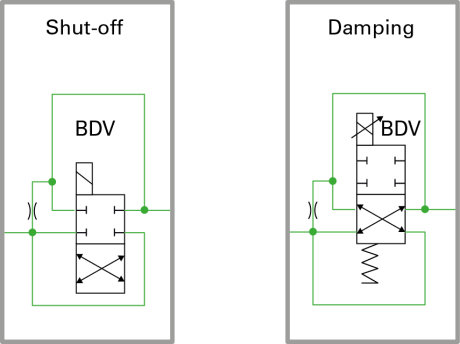
The “Damping regulation hydraulic module” allows instead the oil flow regulation between the suspension cylinder bottom-side chamber and the accumulator (fig. 5). In this case, we can obtain a complete suspension shut-off.
Likewise, we can obtain also the rod-side chamber shut off, cutting off its connection with the accumulator and the pressure regulation systems.
Some “multi-cylinder” modules are also available and they permit to control separately the springs of the two suspension cylinders to attain, for instance, the vehicle roll stabilization.
The various hydrauIic modules (sections) can be assembled one another to obtain a single unit. Their assembly is quite simple since each of the surfaces of the various modules performs a precise function:
– The right and the left surfaces are intended for the assembly of modules
– The rear one for the hydraulic feeding
– The front one for the connection with the suspension cylinders
– The upper one for the valve housing
– The lower one for fixing the unit to the vehicle.
The so assembled block can be mounted in whatever position and orientation. Accumulators can be provided with the optimal sizes according to the dimensions of the suspension cylinders. In this case are suggested accumulators welded with electronic beam for their better quality-price ratio.
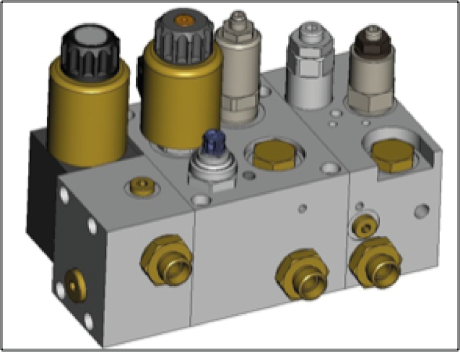
The necessary electronic unit for the Modular Control System operation is available upon demand and includes a position sensor and a position control unit. It is configured according to the hydraulic data of the system and, on demand, it can be customized, modifying its algorithms and parameters. Moreover, it can:
Be equipped with particular components that prevent the tampering of the set parameters by an operator or third parties.
Dialogue with the CAN BUS instruments of the machine.
Currently it is configured in compliance with the CAN open protocol, but other protocols can be introduced.
It is available a touch-screen display that allows modifying some base parameters, providing data for maintenance and diagnostics and able to suit more complex suspension systems.
Electronics allows a proportional and continuous control of the suspension position, of its rigidity and its shock absorption. To achieve the ultimate ride comfort, the suspension can be automatically adapted to the route and the work situation through the use of our so-called “Adaptive Control” technology, but it can also be adapted manually.

